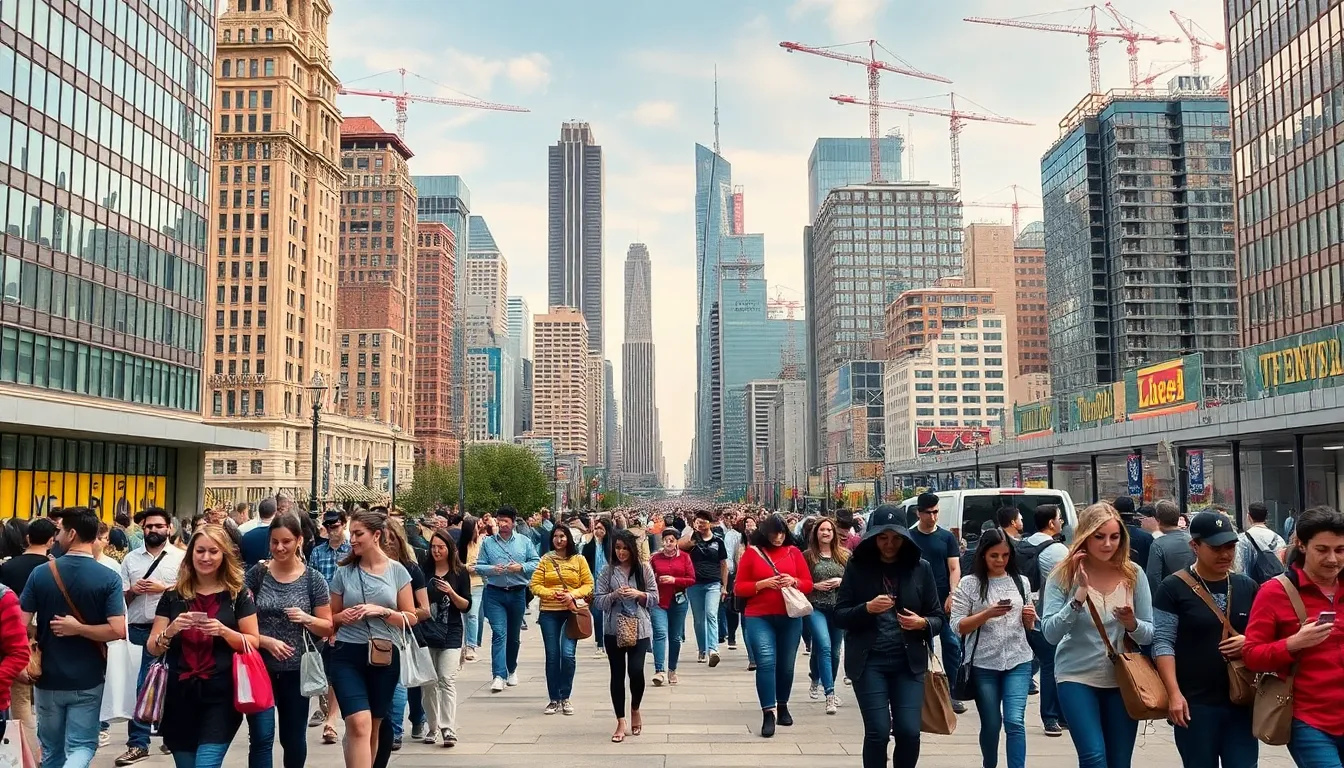As the world’s population keeps skyrocketing, the housing market finds itself in a bit of a pickle. Imagine trying to squeeze a whole circus into a clown car—it’s a tight fit, and someone’s bound to get squished. With more people vying for fewer homes, the demand skyrockets, leading to skyrocketing prices and a few more gray hairs for potential buyers.
Table of Contents
ToggleOverview of Population Growth
Population growth significantly affects housing markets worldwide. According to the United Nations, global population reached 8 billion in November 2022, highlighting rapid increases in urban areas. Cities experience the most strain as people migrate for jobs and opportunities, creating densely populated living conditions.
High demand for housing results from this influx of residents, leading to skyrocketing prices in metropolitan areas. The National Association of Realtors reports that housing prices rose by 16% on average from 2020 to 2021 in many urban regions. With limited land available for development, supply struggles to keep pace with population increases.
Increasing birth rates, combined with longer life expectancies, place additional pressure on housing. By 2050, it’s anticipated that the world population could reach 10 billion, further intensifying existing housing challenges. Migration trends exacerbate localized shortages and prompt concerns over affordability.
Homebuyers face stiff competition, significantly impacting their purchasing power. A growing number of households means more people vie for fewer available properties. Increased prices further complicate access to suitable housing, pushing many toward substandard living conditions when options are limited.
Sustainability becomes a pressing issue amid this growth. As urban areas expand, finding eco-friendly development solutions proves crucial. Balancing population demands with sustainable practices ensures a more resilient housing market. While projected growth presents challenges, it also prompts innovative strategies for meeting housing needs in coming decades.
Key Factors Contributing to Population Growth

Population growth stems from various interconnected factors that influence housing demands. Urbanization trends and changes in birth rates and immigration significantly shape demographic shifts worldwide.
Urbanization Trends
Urban areas attract people seeking better job prospects and improved living conditions. Increased migration to cities creates dense housing demands and pushes up prices. Nearly 55% of the global population now lives in urban settings, with expectations to rise to 68% by 2050. This rapid urbanization results in limited housing availability, challenging current infrastructure. Strained by high demand, cities face significant pressure to accommodate growing populations. Metropolitan regions often see intensified competition for housing, further driving up costs and limiting options for residents.
Birth Rates and Immigration
Birth rates play a crucial role in shaping population dynamics. While many developed countries experience declining birth rates, emerging economies often see rising numbers. This growth, combined with immigration, alters the demographic landscape. In 2020, global migration contributed to an increase of around 280 million people, intensifying housing pressures in urban centers. Countries that welcome immigrants often witness a surge in housing demand due to diverse cultural and economic needs. Housing markets must adapt quickly to accommodate these population shifts as new residents seek affordable options.
Impact of Population Growth on Housing Demand
Population growth significantly affects housing demand. The increase in residents leads to heightened competition for available properties, particularly in urban areas.
Increase in Housing Prices
Existing housing inventory struggles to keep pace with population growth. This competition leads to rising housing prices; for instance, prices surged by 16% from 2020 to 2021, as reported by the National Association of Realtors. Many potential buyers find it increasingly difficult to enter the market. As demand outstrips supply, affordability concerns escalate. Factors such as limited land for new developments, coupled with increasing birth rates, create a perfect storm for soaring prices. Housing becomes a sought-after commodity, pushing many to seek alternative living arrangements or substandard conditions.
Strain on Infrastructure
Population growth exerts immense pressure on urban infrastructure. The increase in residents leads to rising demands for transportation, sanitation, and public services. Many cities face challenges in upgrading these systems quickly. Overcrowded public transit, insufficient waste management services, and limited educational facilities become common issues. With nearly 55% of the global population residing in cities, this number is projected to grow to 68% by 2050. Urban planners must adapt rapidly to address these challenges. Failure to do so can result in deteriorating living conditions and increased public discontent.
Housing Supply Challenges
Population growth intensifies housing supply challenges, complicating efforts to provide adequate living spaces for burgeoning urban populations.
Zoning Laws and Regulations
Zoning laws often restrict property development, impacting how land can be utilized. These regulations can delay housing projects, as developers navigate complex approval processes. Strict zoning can limit the construction of affordable housing options, exacerbating shortages. Adjusting these regulations can create more opportunities for diverse housing types, including multifamily units and mixed-use developments. Policymakers face pressure to modify outdated zoning laws to accommodate growing populations effectively.
Construction Challenges
Construction timelines increase due to labor shortages and rising material costs, further straining the housing supply. Developers encounter difficulties in securing skilled labor, with a significant workforce gap in the construction industry. Material shortages, partly spurred by global supply chain disruptions, heighten project delays. Innovative construction techniques, like modular housing, present potential solutions, yet their adoption remains slow. Effective collaboration among stakeholders can drive improvements, fostering timely construction to meet increasing housing demand.
Solutions to Mitigate the Impact
Mitigating the effects of population growth on housing requires focused efforts and strategic planning. Effective solutions can help address challenges in urban areas.
Sustainable Urban Planning
Sustainable urban planning prioritizes eco-friendly development and smart resource usage. Integration of green spaces can enhance livability and support environmental health. Mixed-use developments promote density while decreasing urban sprawl, making efficient use of existing infrastructure. Smart public transportation systems alleviate traffic congestion, improving residents’ quality of life. Consideration of renewable energy sources can help cities become more resilient to housing demands. Policymakers must engage communities in the planning process, ensuring that developments reflect true local needs.
Affordable Housing Initiatives
Affordable housing initiatives tackle the growing issue of housing scarcity amid rising demand. Governments can incentivize developers to create more budget-friendly units through tax breaks and streamlined permitting processes. Partnerships with non-profit organizations amplify efforts to provide housing solutions, focusing on low-income families. Housing vouchers enable residents to afford living in higher-cost areas, bridging the financial gap. The construction of modular housing offers a flexible and quicker resolution to housing shortages, though adoption remains slow. Continuous monitoring of local housing markets ensures that policies adapt and remain effective as population dynamics shift.
Population growth significantly impacts housing markets worldwide. As urban areas become increasingly crowded the competition for available properties intensifies, driving prices higher and making it difficult for many to find affordable living spaces. The strain on infrastructure and public services compounds these challenges, highlighting the urgent need for innovative solutions.
Sustainable urban planning and updated zoning laws are critical to addressing these issues. By prioritizing eco-friendly development and fostering collaboration among stakeholders, cities can better accommodate growing populations. As the world approaches 10 billion residents by 2050, proactive measures are essential to ensure that housing remains accessible and meets the diverse needs of all citizens.





